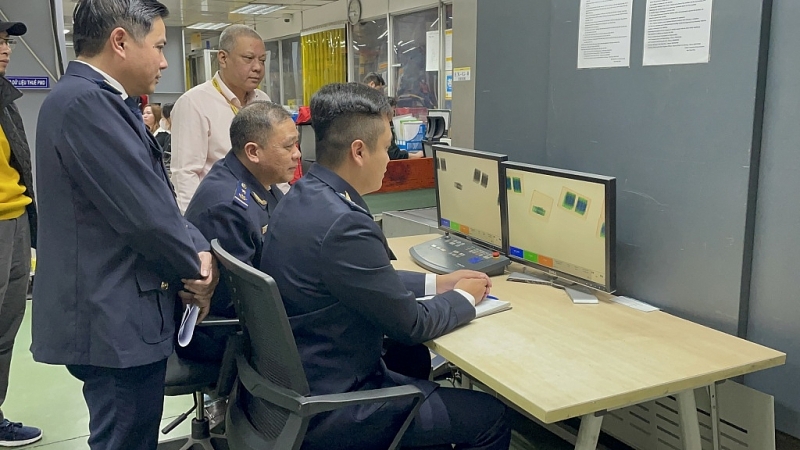Counterfeit goods in small e-commerce parcels challenge enforcement agencies
The rapid growth of e-commerce has introduced significant challenges for authorities dealing with counterfeit goods. Counterfeit products, often concealed in small parcels sent through e-commerce channels, have become a prominent issue for enforcement agencies.
 |
|
Officials of the Express Customs Branch (Hanoi Customs Department) monitor goods through the scanning machine, February 2023. Photo: Ngọc Linh |
Counterfeit concerns on the rise
E-commerce transactions via marketplaces, social media, and shopping apps have surged in recent years, becoming a shopping habit, especially among young consumers worldwide. With just a smartphone, people can buy a vast range of products, from clothing and electronics to food and cosmetics. Unfortunately, some shoppers unknowingly purchase counterfeit items, as online scams have become more complex.
At a recent anti-counterfeit workshop organized by Vietnam’s Intellectual Property Office (IP Office) in partnership with the EU-funded IP Key SEA Project, data revealed that 88% of ASEAN consumers have encountered counterfeit goods, and 70% reported buying fake items. Notably, one in four consumers knowingly bought non-authentic products.
Anthony Manuguerra, Enforcement Specialist at the EU Intellectual Property Office (EUIPO), noted that online platforms have become a major channel for counterfeit goods in ASEAN due to insufficient cross-border IP enforcement. Complex e-commerce developments, including live streaming and AI/VR technologies, make it challenging to trace online counterfeit sellers.
Manuguerra highlighted that most transactions on e-commerce platforms involve small parcels shipped directly from producers, allowing counterfeiters to “hide in plain sight” and operate across borders. European inspections have revealed that small parcels and travelers’ “gifts” often contain counterfeit items sent through express delivery services.
Counterfeit producers also use cross-platform strategies such as affiliate marketing programs, e-commerce platforms in regions with weak IP laws, and multichannel tactics to reach customers. This practice poses challenges for legitimate businesses defending their brands and complicates enforcement efforts.
Cooperation key to effective detection
According to Tran Le Hong, Deputy Director General of Vietnam’s IP Office, managing product quality on e-commerce platforms is a challenging task that requires coordinated interagency cooperation. Authorities are currently facing difficulties in addressing counterfeit goods in the online environment.
One common issue is identifying counterfeit sellers. Although customers can see sellers' addresses online, many listed locations turn out to be “ghost addresses” when authorities attempt to investigate.
Ninoslav Babić, Senior Administrative Advisor at Croatia’s Customs Directorate, added that counterfeit goods sold online often have significant price differences. Violations generally involve low-value items shipped in small parcels, which are becoming more common in e-commerce transactions.
When violations are detected, enforcement agencies like the Police and Customs often lack information on the source markets, shipping data, origin, and product characteristics, making it challenging to determine appropriate action. Furthermore, once items are confirmed as counterfeit, storage and disposal become additional burdens for enforcement agencies.
In many countries, enforcement agencies must bear the costs of storing and destroying counterfeit goods, especially for items requiring prolonged storage or specific conditions, creating logistical and financial difficulties.
Fabrice Ferrono, Regional IP Counsellor for ASEAN, INPI France in ASEAN, explained that enforcement agencies globally are aware of this issue. Interpol, for example, has launched multiple operations to address online counterfeit sales, including in ASEAN.
Governments in ASEAN are also collaborating to combat online counterfeit sales. The ASEAN IP Rights Action Plan (2016-2025) highlights two main objectives. First, to establish an online enforcement data exchange, as shared information is critical in combating counterfeiters. If ASEAN countries share key data on IP violations, offenders cannot easily shift operations across borders.
Moreover, brand owners can contribute to data exchange efforts. Shared data enables Customs to assess IP risks more effectively, providing high-quality information for comprehensive IP protection.
The second focus of the ASEAN action plan is to develop guidelines for online enforcement, promoting a harmonized approach to counter online counterfeiting across the region. A consistent strategy among ASEAN countries will help brand owners and consumers identify counterfeits and report abuse more easily.
Ferrono emphasized that initiatives like the ASEAN Single Window provide a legal framework for a central database that records action requests and temporarily detains IP-infringing goods. This initiative also facilitates information exchange among Customs agencies, reinforcing regional IP enforcement efforts.








